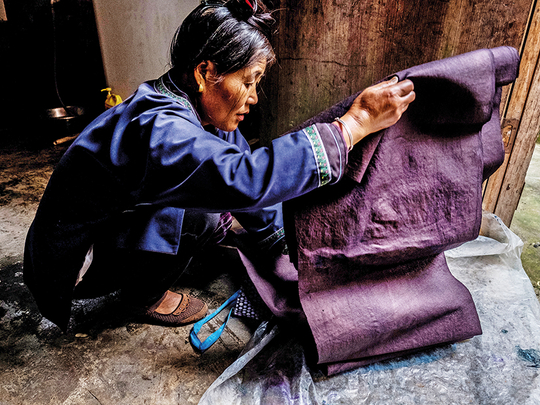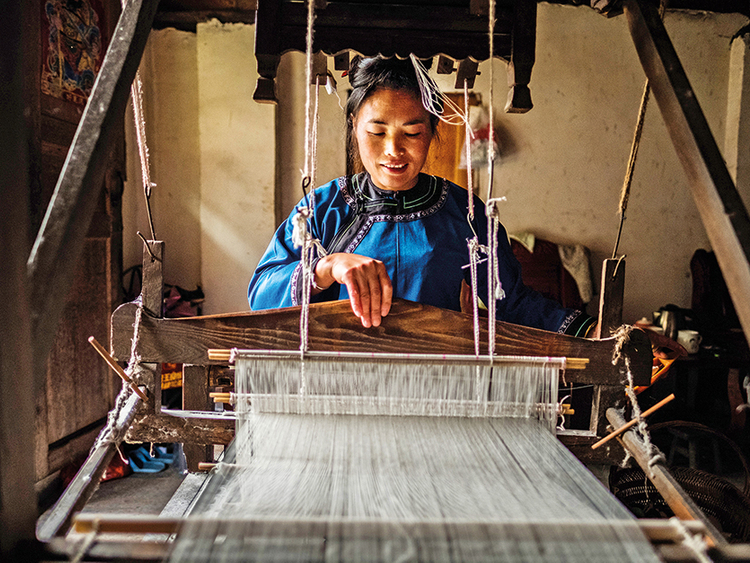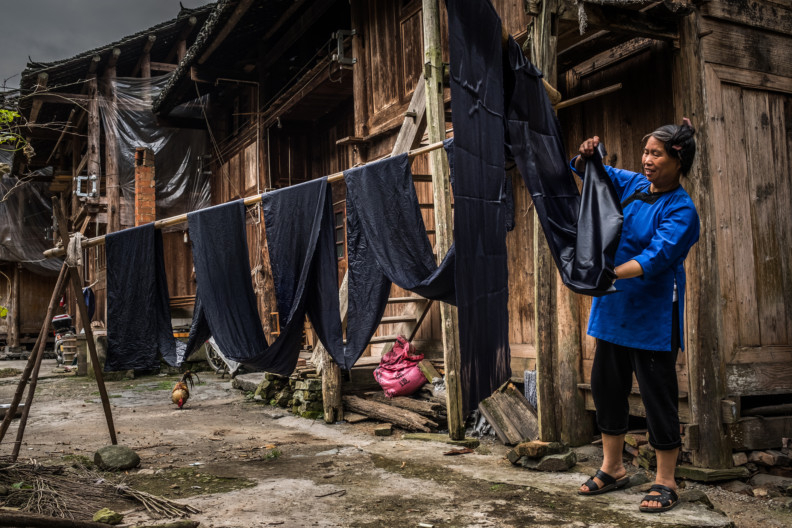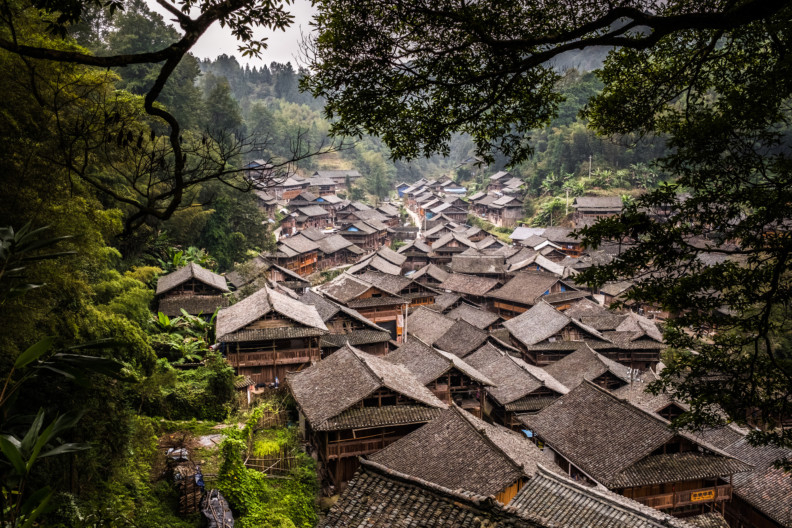
The young woman sat at the foot of the wooden loom and began to weave. As her fingers passed the orange shuttle back and forth through the delicate cotton threads, the creaky contraption sprang to life.
Yang Xiuying — a plucky woman no taller than the loom — peered over her granddaughter’s shoulder, inspecting the newly emerging fabric for flaws. Ever since she was a young girl, Yang, 74, has been weaving and dyeing indigo textiles using techniques that the ethnic Dong in the southern Chinese province of Guizhou have passed down from mother to daughter over generations.
“You can’t buy this type of handmade cloth at the market,” Yang said, patting a bolt of gleaming indigo-coloured cloth with her wrinkled, navy-stained hands.
Here in Dali, an ancient village nestled in verdant hills, making indigo cloth has long been a part of life, no less important to the Dong than farming rice or fermenting fish.
Even in this era of fast fashion, many Dong women still devote countless hours to making the dark, glossy cloth. The fabric must be woven, wrung, scrubbed and pounded before it can be used to create traditional Dong cotton garments — dark navy costumes with colourful flower trim for the women and plain indigo for the men.
“For a Dong family, having a loom is just as important as having a cow,” said Lai Lei, the founder of a weaving and dyeing co-op in a nearby village. “As children, we grow up listening to the sound of the loom.”
Dyeing is so woven into Dali’s culture that the practice even survived the Cultural Revolution, when many other Dong traditions, such as shamanism, were stamped out by communists trying to destroy what they saw as a feudal past.
But the traditions have come under a different threat since China’s market economy has accelerated in recent decades. As the lure of work and education has drawn youth to China’s growing cities, few young Dong women are left in villages like this one.
Of those who remain, even fewer show interest in learning the labour-intensive techniques of indigo dyeing.
“I want to teach my daughters, but they don’t want to learn,” said Zhang Yuyuan, 75, as she stepped back from plunging fabric into a navy-blue bath. “They say, ‘We’ll just mess it up, so you should just do it’.”
Hoping to save Dali’s folk traditions, provincial officials in 2011 invited in the Global Heritage Fund, a preservation organisation based in California.
The Global Heritage Fund has begun working with Atlas Studio, a Beijing-based design studio, to set up a weaving and dyeing co-op in Dali. The aim is twofold: to create opportunities to work closer to home and to persuade young Dong women to learn their traditions.
“For a long time, Guizhou has known that one of its strongest cultural resources is the ethnic minority villages,” said Kuanghan Li, the China programme director of the Global Heritage Fund. “Now rural villages are a hot topic in China.”
Tourism has yet to take off in Dali, though it may only be a matter of time. Unlike many villages in China where preservation has been undertaken with a heavy hand, the village has the feel of an untouched oasis, in part because of its remote location.
Even today, it is accessible only by a narrow mountain road that winds through lush bamboo forests before descending into a valley where sloping grey-tiled rooftops huddle closely together.
A recent visit to the village found the few hundred or so residents hard at work. Nearly every family grows its own rice and indigo, and both were ready for harvest.
In the busy autumn mornings, it is the Dong women who wake first. The roosters were still asleep and the sky dark when Yang Xiukui stepped outside to start her day’s work. She folded a long length of indigo cloth and lay it onto a flat stone surface.
Using a heavy wooden mallet, Yang, 55, began to pound the fabric. With each thump, the cloth grew brighter, acquiring a shiny gloss. That lustre — achieved through the application of cowhide extract and, at times, egg whites — is prized by Dong women. When they wear their handmade indigo clothes for holidays and festivals, the women will inspect the sheen of one another’s handiwork in the spirit of friendly competition.
As Yang worked, a chorus of roosters joined the plinking of mallets to awaken the village. Sleepy children stumbled to school along stone-paved paths while older people chatted on doorsteps of traditional wooden homes.
Yang brought the now-gleaming indigo cloth to a covered plastic tub in the corner of her still dark kitchen. She removed the lid, releasing a pungent, fermented odour. Inside was a dark blue, frothy liquid.
Almost every Dong woman over 40 has a plastic tub to hold indigo dye bath. By tradition, the placement of the tub within the house is crucial, and must be made according to principles of feng shui, the ancient practice of arranging objects to improve one’s luck.
One year, Yang said, she placed the tub in another part of the house, not realising it had bad feng shui. The dye — which is made from a mixture of indigo leaves, rice alcohol, wild plants and lye — was ruined, she said.
Dong women believe that other factors can spoil the dye. Women who are pregnant or menstruating, for example, are expected to stay away. Li of the Global Heritage Fund recounted one time when it became apparent that a dye bath had been ruined because the cloth wasn’t turning colour.
“All the women looked around at each other and just said, ‘OK, who here is pregnant?’” she said.
Yang plunged the fabric into the dye bath, making sure to soak each section thoroughly. Several rounds of soaking and drip-drying later, she hung the heavy cloth on a wooden pole to dry. After a quick meal of chili fermented fish, sauteed vegetables and rice, she hopped onto the back of her husband’s motorbike and headed out for a full day of harvesting rice in the fields. It was only 9am.
The next morning, Yang repeated the entire process. In total, it takes Dong women about two weeks to colour a single bolt of cloth into the desired rich shade of indigo.
“They say whoever has the darkest stains on her hands makes the best cloth,” Yang said proudly, as she held out her purple-streaked hands.
–New York Times News Service
















